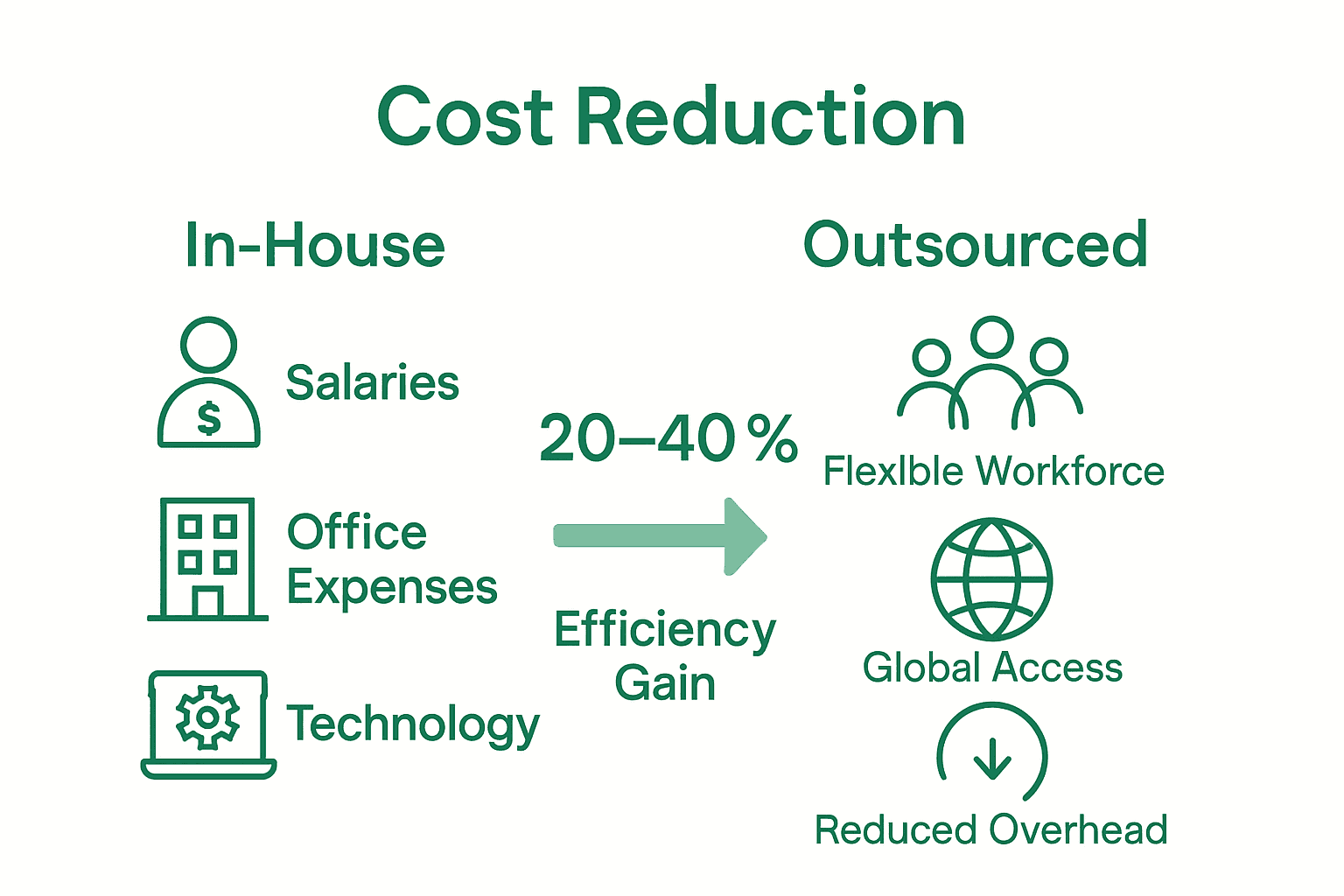Nearly 60 percent of outsourcing projects fall short of expectations, leaving many businesses searching for the right strategy to gain real value. Outsourcing can offer more than just lower costs when executed with a clear plan and smart vendor choices. Knowing how to tap into global talent, scale operations, and improve productivity can set your company apart while avoiding common mistakes that hurt your bottom line.
Defining Outsourcing and Its Core Benefits
Outsourcing represents a strategic business approach where organizations contract external service providers to manage specific operational functions or processes traditionally handled in-house. By leveraging external talent and resources, companies can focus on their core competencies while achieving significant operational efficiencies.
At its fundamental level, outsourcing allows businesses to expand capabilities without increasing internal workforce size or making substantial capital investments.
 Organizations can strategically transfer non-core activities like customer support, data processing, IT infrastructure management, and administrative tasks to specialized service providers. Understanding Outsourcing Benefits for Companies reveals how this approach transforms traditional operational models.
Organizations can strategically transfer non-core activities like customer support, data processing, IT infrastructure management, and administrative tasks to specialized service providers. Understanding Outsourcing Benefits for Companies reveals how this approach transforms traditional operational models.
The core benefits of outsourcing extend far beyond simple cost reduction. Key advantages include:
- Scalability: Quickly adjust workforce and capabilities based on business needs
- Access to Global Talent: Tap into specialized skills worldwide
- Operational Flexibility: Reduce fixed overhead costs and increase adaptability
- Enhanced Productivity: Allow internal teams to concentrate on strategic objectives
- Technology Integration: Leverage advanced technological capabilities without direct investment
Research indicates that successful outsourcing strategies involve careful assessment of organizational requirements, thorough vendor selection, and establishing clear performance metrics. By understanding these nuanced dynamics, businesses can transform outsourcing from a mere cost-saving mechanism into a powerful growth and innovation catalyst.
Key Types of Outsourcing for Businesses
Business Process Outsourcing (BPO) represents a sophisticated strategy where organizations strategically delegate specific operational functions to external service providers. Based on comprehensive research, four primary outsourcing models emerge, each designed to address unique organizational needs and strategic objectives.
The first category, Comprehensive BPO, involves transferring entire operational domains like customer support, finance, human resources, and information technology to specialized external partners. This model allows businesses to completely offload complex, non-core functions while maintaining strategic oversight. Complete Guide to Outsourcing Business Operations provides deeper insights into implementing these comprehensive strategies.
Researchers have identified several distinct outsourcing types based on strategic alignment and resource characteristics:
- Comprehensive BPO: Full-scale transfer of entire operational domains
- Selective BPO: Targeted outsourcing of specific functional processes
- Transitional BPO: Gradual transfer of operations with phased implementation
- Offshore BPO: Geographic relocation of processes to leverage cost advantages
The selection of an appropriate outsourcing model depends on multiple factors, including organizational complexity, technological infrastructure, financial constraints, and strategic growth objectives. Successful implementation requires careful evaluation of potential service providers, clear performance metrics, and a robust communication framework to ensure seamless integration and sustained operational excellence.
How Outsourcing Reduces Operational Costs
Operational cost reduction emerges as a critical strategic advantage of outsourcing, allowing businesses to transform their financial landscape by strategically reallocating resources and minimizing expensive internal infrastructure investments. By transferring non-core functions to specialized external providers, organizations can dramatically reduce overhead expenses associated with recruitment, training, technology, and workspace maintenance.
The financial mechanics of outsourcing create substantial cost savings across multiple dimensions. Companies can eliminate substantial fixed expenses like full-time employee salaries, benefits, workplace equipment, and ongoing training programs by converting these into variable, project-based costs. Why Outsource Non-Core Functions provides deeper insights into how businesses can strategically minimize expenditures through targeted outsourcing strategies.
Key cost reduction mechanisms in outsourcing include:
- Labor Cost Optimization: Access skilled workers at significantly lower rates
- Infrastructure Expense Reduction: Eliminate costs for physical workspace and equipment
- Technology Investment Minimization: Leverage provider’s existing technological infrastructure
- Scalable Resource Allocation: Pay only for services and hours actually required
- Administrative Overhead Elimination: Reduce expenses related to HR, recruitment, and management
Research consistently demonstrates that intelligent outsourcing can help organizations reduce operational expenses by 20-40% while simultaneously improving operational efficiency.
The key lies in selecting the right service providers, establishing clear performance metrics, and maintaining strategic alignment between outsourced functions and core business objectives.
Analyzing Return on Investment and Savings
Return on Investment (ROI) in outsourcing represents a critical metric that goes beyond simple cost calculations, encompassing a comprehensive evaluation of strategic value, operational efficiency, and long-term financial performance. By systematically analyzing the economic impact of outsourcing decisions, businesses can transform external partnerships into powerful competitive advantages.
The ROI calculation for outsourcing involves multiple interconnected factors that extend well beyond immediate financial savings. Companies must consider direct cost reductions, productivity improvements, access to specialized talent, technological advancements, and the ability to redirect internal resources toward core strategic initiatives.
 Outsource Repetitive Tasks Guide for Seamless Efficiency provides valuable insights into quantifying these multifaceted benefits.
Outsource Repetitive Tasks Guide for Seamless Efficiency provides valuable insights into quantifying these multifaceted benefits.
Key components for comprehensive ROI analysis include:
- Direct Cost Savings: Quantify reduction in labor, infrastructure, and operational expenses
- Productivity Metrics: Measure efficiency gains and output improvements
- Strategic Resource Allocation: Evaluate time and resources redirected to core business functions
- Quality Enhancement: Assess improvements in service delivery and operational standards
- Technology and Innovation: Calculate value of accessing advanced technological capabilities
Research suggests that successful outsourcing strategies can generate ROI ranging from 25% to 70%, depending on the industry and specific implementation approach. However, achieving optimal returns requires a sophisticated approach that includes rigorous vendor selection, clear performance metrics, continuous performance monitoring, and maintaining strategic alignment between outsourced functions and organizational objectives.
Common Pitfalls and Cost-Benefit Mistakes
Outsourcing failures often stem from complex strategic missteps that undermine the potential financial and operational benefits of external partnerships. Many organizations rush into outsourcing without comprehensive planning, leading to costly mistakes that can negate anticipated cost savings and operational improvements. Understanding these potential pitfalls is crucial for developing a robust and effective outsourcing strategy.
The most critical errors typically emerge from inadequate vendor selection, poor communication frameworks, and misaligned organizational expectations. Companies frequently underestimate the complexity of managing external relationships, failing to establish clear performance metrics, communication protocols, and quality control mechanisms. How to Outsource Back Office for Business Efficiency offers strategic guidance on navigating these potential challenges and maintaining operational integrity.
Common outsourcing cost-benefit mistakes include:
- Insufficient Due Diligence: Selecting vendors without comprehensive background checks
- Unclear Contractual Agreements: Failing to define precise scope, deliverables, and performance expectations
- Inadequate Risk Management: Neglecting potential security, compliance, and operational risks
- Poor Cultural and Communication Alignment: Overlooking potential language and operational communication barriers
- Unrealistic Cost Expectations: Assuming immediate and dramatic cost reductions without strategic implementation
Research indicates that approximately 50-60% of outsourcing initiatives fail to deliver their anticipated benefits, primarily due to these strategic oversights. Successful outsourcing requires a holistic approach that balances cost considerations with comprehensive vendor evaluation, robust communication strategies, continuous performance monitoring, and flexibility to adapt to evolving business requirements.
Unlock Significant Cost Benefits with Expert Outsourcing Solutions
The article clearly highlights the challenge of reducing operational costs while maintaining quality and efficiency through outsourcing. If you are seeking to optimize your business processes, scale your workforce flexibly, and tap into specialized global talent without heavy upfront investments, it is critical to work with a proven partner who understands these complexities. NineArchs LLC specializes in delivering tailored outsourcing services such as business process outsourcing, virtual assistance, and custom software development, all designed to help you achieve measurable cost savings and operational excellence.
Discover how you can avoid common outsourcing pitfalls and maximize your return on investment by partnering with professionals who focus on clear performance metrics and strategic alignment. With NineArchs, your business can reduce overhead expenses, improve productivity, and harness advanced technological capabilities with confidence.
Ready to transform your operational costs into a competitive advantage?

Explore our comprehensive outsourcing services and start your journey to cost-efficient growth today. Connect with specialists who can tailor solutions for your unique needs at Contact NineArchs and learn more about Why Outsource Non-Core Functions. For insight into strategic operational improvements, visit How to Outsource Back Office for Business Efficiency. Don’t wait to reduce costs and elevate productivity. Visit https://ninearchs.com/contact now and take the first step toward smarter outsourcing.
Frequently Asked Questions
What are the core benefits of outsourcing?
Outsourcing offers several key advantages, including scalability, access to global talent, operational flexibility, enhanced productivity, and technology integration without the need for direct investment.
How does outsourcing help reduce operational costs?
Outsourcing reduces operational costs by converting fixed expenses like salaries and infrastructure into variable costs, optimizing labor costs, and eliminating the need for extensive technology investments.
What types of outsourcing models are available to businesses?
Businesses can choose from several outsourcing models, including comprehensive BPO (full transfer of operations), selective BPO (targeted outsourcing of specific processes), transitional BPO (gradual transfer of operations), and offshore BPO (geographic relocation for cost advantages).
How can businesses analyze the return on investment (ROI) from outsourcing?
To analyze ROI from outsourcing, businesses should evaluate direct cost savings, productivity metrics, quality enhancements, and the strategic allocation of resources redirected towards core functions.









